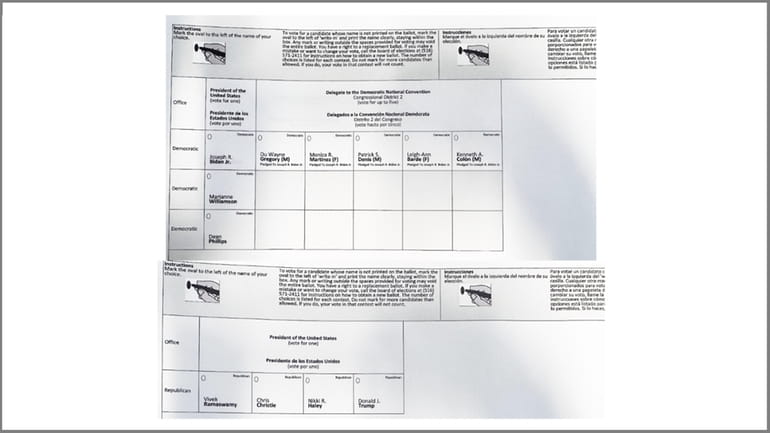Another round of moot NY presidential primaries

Sample New York Democratic and GOP primary ballots in the 2024 presidential election. Credit: Nassau County Board of Elections
Got your doubts that the national choices resulting from our two-party “system” are all they could be? The upcoming New York presidential primary might not allay them.
Starting Saturday, millions of dollars will be spent on this statewide non-contest — even though President Joe Biden and ex-President Donald Trump have amassed enough support to lock up their nominations.
This primary is likely to look more like a candidate séance than a relevant choice by the people.
On the Republican ballot, Trump’s name will appear along with those of once-contenders Chris Christie, Vivek Ramaswamy and Nikki Haley.
All of them quit campaigning after failing to gain traction, but did not legally withdraw from the ballot before the state’s Feb. 6 deadline for doing so.
On the Democratic ballot, Biden’s name will appear with those of Marianne Williamson and Dean Phillips, who made no headway in earlier primaries.
Biden’s name will be accompanied by pledged delegates from each of the state’s congressional districts. Local voters can choose to support some, none, or all of them. His rivals have not filed delegate names.
The state GOP will choose its district delegates once Trump officially wins.
The parties’ noncompetitive primaries do serve as opportunities for demonstrations of dissent. In the Midwest, thousands of people who wanted to express dissatisfaction with Biden’s position on the Gaza war recently voted for “uncommitted.” They totaled one out of five in Minnesota.
In Florida this week, dissenting Republicans made up a similar portion of the turnout. Haley’s presence on ballots there drew 14%, Gov. Ron DeSantis got 3.7 %, Christie nearly 1%, and three other phantom “candidates” totaled about half a percentage point.
These are examples of primaries as civic protests. They get attention, for a while, from the leading candidates worried about how the dissenters will vote in November.
The party powerful always shape national primary rules. In 2019, Trump’s state Republican leaders in Nevada, South Carolina and Kansas canceled their contests, perhaps keeping any challenges from gaining steam.
Also four years ago, New York Democrats sought to call off their presidential primary. It was clear by this point that Biden would be the nominee. But representatives of rival candidates Andrew Yang and Bernie Sanders successfully sued to reinstate the contest, and it was held that June.
In the ensuing exercise, Biden won nearly 65%, Sanders 16%, and among eight other candidates, Elizabeth Warren drew about 5%. This had no impact on the wider race.
Thus we had the first Biden-Trump contest, which, notwithstanding the Trump camp’s previously-unheard-of attempt to fix results after the fact, Biden won 306-232 in the Electoral College and 52%-47% in the popular vote.
Early voting in this year’s New York presidential primary (for party members only) will be conducted between this Saturday, March 23, and the following Saturday, March 30. Primary day is Tuesday, April 2. Longtime election operatives guess that overall turnout will be between 10 and 20%.
A second primary day, for congressional and legislative seats, will be held June 25. Some ask: Why bother with this one?
“Because it’s a civic duty,” said a veteran state election official, adding: “Of course, the odds of your influencing the outcome in the primary might be less than the odds you’d be injured on your way to the polls. But generally, it’s always the people who show up that make the decisions.”
Columnist Dan Janison's opinions are his own.

